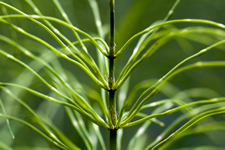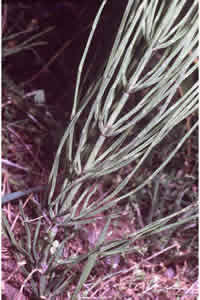Horsetail Equisetum arvense

- Common Names
- Horsetail , Shavegrass
- Botanical Name
- Equisetum arvense
- Family
- Eqisetaceae
Medicinal Uses & Benefits of Horsetail
![]() How to Use|
Side Effects |
Plant & Garden|
How to Use|
Side Effects |
Plant & Garden|
- Medicinal Uses: * Bladder Infection (UTI)
* Kidney
* Osteoporosis
- Properties: * Antiscorbutic * Astringent * Diuretic * Refrigerant * Styptic * Tonic
- Parts Used: All ariel parts
- Constituents: primarily silica and potassium salts, small amounts of nicotine. horsetail from european sources contains the anti-allergy compound quercetin.
How to Use: Horsetail
The primary use of the horsetail is as a diuretic. Gently stimulating increased urinary flow, horsetail helps "flush" infectious bacteria out of the bladder without altering the body's balance of electrolytes. The powdered form of the herb is better when electrolytes may be depleted. It's also the form of the herb being investigated as a treatment for age-related memory impairment. 1
While horsetail is accepted in herbal traditions as a proven herb to maintain healthy skin, nails and hair, the supposition that silica is main active ingredient responsible for these properties is questioned by some modern herbalists. The objective evidence is sorely lacking both for the bioavailability of silica and the role silicon plays in the body. This is not to say horsetail is not effective, but rather calls into question the mechanism by which this most ancient of plants affects human metabolism.2
Preparation Methods & Dosage :Usually in tea, tinctures and encapsulations. Horsetail can be taken alone, but is often combined with other herbs to enhance and compliment the effects you are seeking. Suggestions would include Oregon Grape root, and marshmallow root for a healthy urinary system, and nettle for bone health. Bring horsetail to a boil then simmer a minimum of three hours to extract the main chemical constituents. Add teaspoon of sugar to the infusion when making horsetail tea. The sugar will pull more silicon out of the plant.
Horsetail Side Effects: When taking horsetail powder for its diuretic effect, be sure to drink extra water for maximum benefit. Avoid if there are kidney stones. Don't take horsetail herb if you take an ACE inhibitor for high blood pressure and you have congestive heart failure, as the combination of the herb and the drug can cause accumulation of excessive potassium. Not recommended while pregnant. 1
Plant Description

Robert H. Mohlenbrock @ / USDA SCS. (1989)
A flowerless plant that dates from the carboniferous period, (prehistoric fossils hold the stems of gigantic Equisetacae, those existing today are mere dwarfish representatives.) The name comes from the jointed stems of the plants which earned the popular names of Horsetail, Bottle brush and Paddock pipes.
- Mountain Rose Herbs (2008-07-12)
- Hoffmann, David. "Medical Herbalism: The Science and Practice of Herbal Medicine" (p. 571). Healing Arts Press. (2010-12-15)(p. 14)











